Impact of Future Land Use Change on Large Carnivores Connectivity in the Polish Carpathians
Abstract
:1. Introduction
2. Materials and Methods
2.1. Study Area
2.2. Approach
2.3. Input Data
2.4. Land Use Change and Connectivity Assessment
3. Results
3.1. Land Use Changes
3.2. Connectivity Changes in Response to Future Land Use
4. Discussion
5. Conclusions
Author Contributions
Funding
Acknowledgments
Conflicts of Interest
References
- Hamilton, C.M.; Martinuzzi, S.; Plantinga, A.J.; Radeloff, V.C.; Lewis, D.J.; Thogmartin, W.E.; Heglund, P.J.; Pidgeon, A.M. Current and future land use around a nationwide protected area network. PLoS ONE 2013, 8, e55737. [Google Scholar] [CrossRef] [PubMed]
- Newbold, T.; Hudson, L.N.; Hill, S.L.L.; Contu, S.; Lysenko, I.; Senior, R.A.; Börger, L.; Bennett, D.J.; Choimes, A.; Collen, B.; et al. Global effects of land use on local terrestrial biodiversity. Nature 2015, 520, 45–50. [Google Scholar] [CrossRef] [Green Version]
- Visconti, P.; Bakkenes, M.; Baisero, D.; Brooks, T.; Butchart, S.H.M.; Joppa, L.; Alkemade, R.; Di Marco, M.; Santini, L.; Hoffmann, M.; et al. Projecting Global Biodiversity Indicators under Future Development Scenarios. Conserv. Lett. 2016, 9, 5–13. [Google Scholar] [CrossRef]
- Fischer, J.; Lindenmayer, D.B. Landscape modification and habitat fragmentation: A synthesis. Glob. Ecol. Biogeogr. 2007, 16, 265–280. [Google Scholar] [CrossRef]
- Bellard, C.; Bertelsmeier, C.; Leadley, P.; Thuiller, W.; Courchamp, F. Impacts of climate change on the future of biodiversity. Ecol. Lett. 2012, 15, 365–377. [Google Scholar] [CrossRef] [PubMed] [Green Version]
- Estes, J.A.; Terborgh, J.; Brashares, J.S.; Power, M.E.; Berger, J.; Bond, W.J.; Carpenter, S.R.; Essington, T.E.; Holt, R.D.; Jackson, J.B.C.; et al. Trophic downgrading of planet Earth. Science 2011, 333, 301–306. [Google Scholar] [CrossRef] [PubMed]
- Di Minin, E.; Slotow, R.; Hunter, L.T.B.; Montesino Pouzols, F.; Toivonen, T.; Verburg, P.H.; Leader-Williams, N.; Petracca, L.; Moilanen, A. Global priorities for national carnivore conservation under land use change. Sci. Rep. 2016, 6, 23814. [Google Scholar] [CrossRef] [PubMed] [Green Version]
- Chetkiewicz, C.-L.B.; St. Clair, C.C.; Boyce, M.S. Corridors for Conservation: Integrating Pattern and Process. Annu. Rev. Ecol. Evol. Syst. 2006, 37, 317–342. [Google Scholar] [CrossRef]
- Sala, O.E. Global Biodiversity Scenarios for the Year 2100. Science 2000, 287, 1770–1774. [Google Scholar] [CrossRef]
- Titeux, N.; Henle, K.; Mihoub, J.-B.; Regos, A.; Geijzendorffer, I.R.; Cramer, W.; Verburg, P.H.; Brotons, L. Biodiversity scenarios neglect future land use changes. Glob. Chang. Biol. 2016, 22, 2505–2515. [Google Scholar] [CrossRef] [Green Version]
- Selva, N.; Switalski, A.; Kreft, S.; Ibisch, P.L. Why keep areas road-free? The importance of roadless areas. In Handbook of Road Ecology; Van der Ree, R., Grilo, C., Smith, D., Eds.; Wiley-Blackwell: Oxford, UK, 2015; pp. 16–26. ISBN 978-1-118-56818-7. [Google Scholar]
- Ibisch, P.L.; Hoffmann, M.T.; Kreft, S.; Pe’er, G.; Kati, V.; Biber-Freudenberger, L.; DellaSala, D.A.; Vale, M.M.; Hobson, P.R.; Selva, N. A global map of roadless areas and their conservation status. Science 2016, 354, 1423–1427. [Google Scholar] [CrossRef] [PubMed]
- Seto, K.C.; Güneralp, B.; Hutyra, L.R. Global forecasts of urban expansion to 2030 and direct impacts on biodiversity and carbon pools. Proc. Natl. Acad. Sci. USA 2012, 109, 16083–16088. [Google Scholar] [CrossRef] [PubMed] [Green Version]
- Radeloff, V.C.; Hammer, R.B.; Stewart, S.I.; Fried, J.S.; Holcomb, S.S.; McKeefry, J.F. The Wildland–Urban Interface in the United States. Ecol. Appl. 2005, 15, 799–805. [Google Scholar] [CrossRef]
- Haase, D.; Kabisch, N.; Haase, A. Endless urban growth? On the mismatch of population, household and urban land area growth and its effects on the urban debate. PLoS ONE 2013, 8, e66531. [Google Scholar] [CrossRef] [PubMed]
- Hennig, E.I.; Schwick, C.; Soukup, T.; Orlitová, E.; Kienast, F.; Jaeger, J.A.G. Multi-scale analysis of urban sprawl in Europe: Towards a European de-sprawling strategy. Land Use Policy 2015, 49, 483–498. [Google Scholar] [CrossRef] [Green Version]
- Mcdonald, R.I.; Kareiva, P.; Forman, R.T.T. The implications of current and future urbanization for global protected areas and biodiversity conservation. Biol. Conserv. 2008, 141, 1695–1703. [Google Scholar] [CrossRef]
- Carter, S.K.; Pohlman, J.D.; Bergeson, T.L.; Hamilton, C.M.; Pidgeon, A.M.; Radeloff, V.C. Improving the utility of existing conservation plans using projected housing development. Landsc. Urban Plan. 2014, 126, 10–20. [Google Scholar] [CrossRef]
- Price, B.; Kienast, F.; Seidl, I.; Ginzler, C.; Verburg, P.H.; Bolliger, J. Future landscapes of Switzerland: Risk areas for urbanisation and land abandonment. Appl. Geogr. 2015, 57, 32–41. [Google Scholar] [CrossRef]
- Kaim, D. Land cover changes in the Polish Carpathians based on repeat photography. Carpathian J. Earth Environ. Sci. 2017, 12, 485–498. [Google Scholar]
- Lasanta, T.; Arnáez, J.; Pascual, N.; Ruiz-Flaño, P.; Errea, M.P.; Lana-Renault, N. Space–time process and drivers of land abandonment in Europe. CATENA 2017, 149, 810–823. [Google Scholar] [CrossRef]
- Ustaoglu, E.; Collier, M.J. Farmland Abandonment in Europe: An Overview of Drivers, Consequences and Assessment of the Sustainability Implications. Environ. Rev. 2018, 26, 396–416. [Google Scholar] [CrossRef]
- Stürck, J.; Levers, C.; van der Zanden, E.H.; Schulp, C.J.E.; Verkerk, P.J.; Kuemmerle, T.; Helming, J.; Lotze-Campen, H.; Tabeau, A.; Popp, A.; et al. Simulating and delineating future land change trajectories across Europe. Reg. Environ. Chang. 2015. [Google Scholar] [CrossRef]
- Kolecka, N.; Kozak, J.; Kaim, D.; Dobosz, M.; Ginzler, C.; Psomas, A. Mapping Secondary Forest Succession on Abandoned Agricultural Land with LiDAR Point Clouds and Terrestrial Photography. Remote Sens. 2015, 7, 8300–8322. [Google Scholar] [CrossRef] [Green Version]
- Munteanu, C.; Kuemmerle, T.; Boltiziar, M.; Butsic, V.; Gimmi, U.; Lúboš, H.; Kaim, D.; Király, G.; Konkoly-Gyuró, É.; Kozak, J.; et al. Forest and agricultural land change in the Carpathian region-A meta-analysis of long-term patterns and drivers of change. Land Use Policy 2014, 38, 685–697. [Google Scholar] [CrossRef]
- Hostert, P.; Kozak, J.; Kaim, D.; Kuemmerle, T.; Mueller, D.; Ostapowicz, K. Land use and land cover change in the Carpathians after 1989. In Europe’s Ecological Backbone: Recognizing the True Value of Our Mountains, EEA Report 6/2010; European Environment Agency: Copenhagen, Denmark, 2010; pp. 120–122. [Google Scholar]
- Kolecka, N.; Kozak, J.; Kaim, D.; Dobosz, M.; Ostafin, K.; Ostapowicz, K.; Wężyk, P.; Price, B. Understanding farmland abandonment in the Polish Carpathians. Appl. Geogr. 2017, 88. [Google Scholar] [CrossRef]
- UNEP (United Nations Environment Programme). Carpathians Environment Outlook; UNEP: Geneva, Switzerland, 2007. [Google Scholar]
- Jędrzejewski, W.; Niedzialkowska, M.; Mysłajek, R.W.; Nowak, S.; Jędrzejewska, B. Habitat selection by wolves Canis lupus in the uplands and mountains of southern Poland. Acta Theriol. (Warsz.) 2005, 50, 417–428. [Google Scholar] [CrossRef]
- Huck, M.; Jędrzejewski, W.; Borowik, T.; Miłosz-Cielma, M.; Schmidt, K.; Jędrzejewska, B.; Nowak, S.; Mysłajek, R.W. Habitat suitability, corridors and dispersal barriers for large carnivores in Poland. Acta Theriol. (Warsz.) 2010, 55, 177–192. [Google Scholar] [CrossRef]
- Ziółkowska, E.; Perzanowski, K.; Bleyhl, B.; Ostapowicz, K.; Kuemmerle, T. Understanding unexpected reintroduction outcomes: Why aren’t European bison colonizing suitable habitat in the Carpathians? Biol. Conserv. 2016, 195, 106–117. [Google Scholar] [CrossRef]
- Jongman, R.H.G.; Bouwma, I.M.; Griffioen, A.; Jones-Walters, L.; Van Doorn, A.M. The Pan European Ecological Network: PEEN. Landsc. Ecol. 2011, 26, 311–326. [Google Scholar] [CrossRef]
- Mika, M. Spatial Patterns of Second Homes Development in the Polish Carpathians. In The Carpathians: Integrating Nature and Society towards Sustainability SE-35; Kozak, J., Ostapowicz, K., Bytnerowicz, A., Wyżga, B., Eds.; Environmental Science and Engineering; Springer: Berlin/Heidelberg, Germany, 2013; pp. 497–512. ISBN 978-3-642-12724-3. [Google Scholar]
- GUS. Prognoza Ludności na Lata 2014–2050; GUS: Warszawa, Poland, 2014. [Google Scholar]
- Parusel, J.B.; Skowrońska, K.; Wower, A. Korytarze Ekologiczne w Województwie Śląskim—Koncepcja do Planu Zagospodarowania Przestrzennego Województwa. Etap I.; Centrum Dziedzictwa Przyrody Górnego Śląska: Katowice, Poland, 2007. [Google Scholar]
- Price, B.; Kaim, D.; Szwagrzyk, M.; Ostapowicz, K.; Kolecka, N.; Schmatz, D.R.; Wypych, A.; Kozak, J. Legacies, socio-economic and biophysical processes and drivers: The case of future forest cover expansion in the Polish Carpathians and Swiss Alps. Reg. Environ. Chang. 2017, 17, 2279–2291. [Google Scholar] [CrossRef]
- Calabrese, J.M.; Fagan, W.F. A comparison-shopper’s guide to connectivity metrics. Front. Ecol. Environ. 2004, 2, 529–536. [Google Scholar] [CrossRef]
- Verburg, P.H.; Overmars, K.P. Combining top-down and bottom-up dynamics in land use modeling: Exploring the future of abandoned farmlands in Europe with the Dyna-CLUE model. Landsc. Ecol. 2009, 24, 1167–1181. [Google Scholar] [CrossRef]
- Alcamo, J. Chapter Six The SAS Approach: Combining Qualitative and Quantitative Knowledge in Environmental Scenarios. Dev. Integr. Environ. Assess. 2008, 2, 123–150. [Google Scholar] [CrossRef]
- Kozak, J.; Ostapowicz, K.; Szablowska-Midor, A.; Widacki, W. Land abandonment in the Western Beskidy Mts and its environmental background. Ekológia (Bratisl.) 2004, 23, 116–126. [Google Scholar]
- Wypych, A.; Ustrnul, Z.; Schmatz, D.R. Long-term variability of air temperature and precipitation conditions in the Polish Carpathians. J. Mt. Sci. 2018, 15, 237–253. [Google Scholar] [CrossRef]
- Chapron, G.; Kaczensky, P.; Linnell, J.D.C.; von Arx, M.; Huber, D.; Andrén, H.; López-Bao, J.V.; Adamec, M.; Álvares, F.; Anders, O.; et al. Recovery of large carnivores in Europe’s modern human-dominated landscapes. Science 2014, 346, 1517–1519. [Google Scholar] [CrossRef]
- Kutal, M.; Váňa, M.; Suchomel, J.; Chapron, G.; López-Bao, J.V. Trans-Boundary Edge Effects in the Western Carpathians: The Influence of Hunting on Large Carnivore Occupancy. PLoS ONE 2016, 11, e0168292. [Google Scholar] [CrossRef]
- McRae, B.H.; Kavanagh, D.M. Linkage Mapper Connectivity Analysis Software 2011. Available online: http://www.circuitscape.org/linkagemapper (accessed on 3 January 2019).
- Kozak, J.; Ziółkowska, E.; Vogt, P.; Dobosz, M.; Kaim, D.; Kolecka, N.; Ostafin, K. Forest-cover increase does not trigger forest-fragmentation decrease: Case Study from the Polish Carpathians. Sustainbility 2018, 10, 1472. [Google Scholar] [CrossRef]
- Schadt, S.; Knauer, F.; Kaczensky, P.; Revilla, E.; Wiegand, T.; Trepl, L. Rule-based assessment of suitable habitat and patch connectivity for the Eurasian lynx in Germany. Ecol. Appl. 2002, 12, 1469–1483. [Google Scholar] [CrossRef]
- Ziółkowska, E.; Ostapowicz, K.; Kuemmerle, T.; Perzanowski, K.; Radeloff, V.C.; Kozak, J. Potential habitat connectivity of European bison (Bison bonasus) in the Carpathians. Biol. Conserv. 2012, 146, 188–196. [Google Scholar] [CrossRef]
- Bleyhl, B.; Baumann, M.; Griffiths, P.; Heidelberg, A.; Manvelyan, K.; Radeloff, V.C.; Zazanashvili, N.; Kuemmerle, T. Assessing landscape connectivity for large mammals in the Caucasus using Landsat 8 seasonal image composites. Remote Sens. Environ. 2017, 193, 193–203. [Google Scholar] [CrossRef]
- Votsi, N.-E.P.; Zomeni, M.S.; Pantis, J.D. Evaluating the Effectiveness of Natura 2000 Network for Wolf Conservation: A Case-Study in Greece. Environ. Manag. 2016, 57, 257–270. [Google Scholar] [CrossRef]
- Halada, Ľ.; David, S.; Hreško, J.; Klimantová, A.; Bača, A.; Rusňák, T.; Buraľ, M.; Vadel, Ľ. Changes in grassland management and plant diversity in a marginal region of the Carpathian Mts. in 1999–2015. Sci. Total Environ. 2017, 609, 896–905. [Google Scholar] [CrossRef] [PubMed]
- Tokarczyk, N. Forest encroachment on temperate mountain meadows—Scale, drivers, and current research directions. Geogr. Pol. 2017, 90, 463–480. [Google Scholar] [CrossRef]
- Tokarczyk, N. Challenges for the conservation of semi-natural grasslands in mountainous national parks: Case studies from the Polish Carpathians. Carpathian J. Earth Environ. Sci. 2018, 13, 187–198. [Google Scholar]
- Wynn-Grant, R.; Ginsberg, J.R.; Lackey, C.W.; Sterling, E.J.; Beckmann, J.P. Risky business: Modeling mortality risk near the urban-wildland interface for a large carnivore. Glob. Ecol. Conserv. 2018, 16, e00443. [Google Scholar] [CrossRef]
- Myslajek, R.W.; Nowak, S.; Kurek, K.; Tolkacz, K.; Gewartowska, O. Utilisation of a wide underpass by mammals on an expressway in the Western Carpathians, S Poland. Folia Zool. 2016, 65, 225–232. [Google Scholar] [CrossRef]
- Boutin, S. Hunger makes apex predators do risky things. J. Anim. Ecol. 2018, 87, 530–532. [Google Scholar] [CrossRef] [Green Version]
- Blecha, K.A.; Boone, R.B.; Alldredge, M.W. Hunger mediates apex predator’s risk avoidance response in wildland-urban interface. J. Anim. Ecol. 2018, 87, 609–622. [Google Scholar] [CrossRef]
- Evans, M.J.; Rittenhouse, T.A.G.; Hawley, J.E.; Rego, P.W. Black bear recolonization patterns in a human-dominated landscape vary based on housing: New insights from spatially explicit density models. Landsc. Urban Plan. 2017, 162, 13–24. [Google Scholar] [CrossRef]
- Kaim, D.; Radeloff, V.C.; Szwagrzyk, M.; Dobosz, M.; Ostafin, K. Long-term changes of the wildland–urban interface in the Polish Carpathians. ISPRS Int. J. Geo-Inf. 2018, 7, 137. [Google Scholar] [CrossRef]
- Hulva, P.; Černá Bolfíková, B.; Woznicová, V.; Jindřichová, M.; Benešová, M.; Mysłajek, R.W.; Nowak, S.; Szewczyk, M.; Niedźwiecka, N.; Figura, M.; et al. Wolves at the crossroad: Fission-fusion range biogeography in the Western Carpathians and Central Europe. Divers. Distrib. 2018, 24, 179–192. [Google Scholar] [CrossRef]
- Navarro, L.M.; Pereira, H.M. Rewilding Abandoned Landscapes in Europe. In Rewilding European Landscapes; Pereira, H.M., Navarro, L.M., Eds.; Springer International Publishing: Cham, Switzerland, 2015; pp. 3–23. ISBN 978-3-319-12039-3. [Google Scholar] [Green Version]
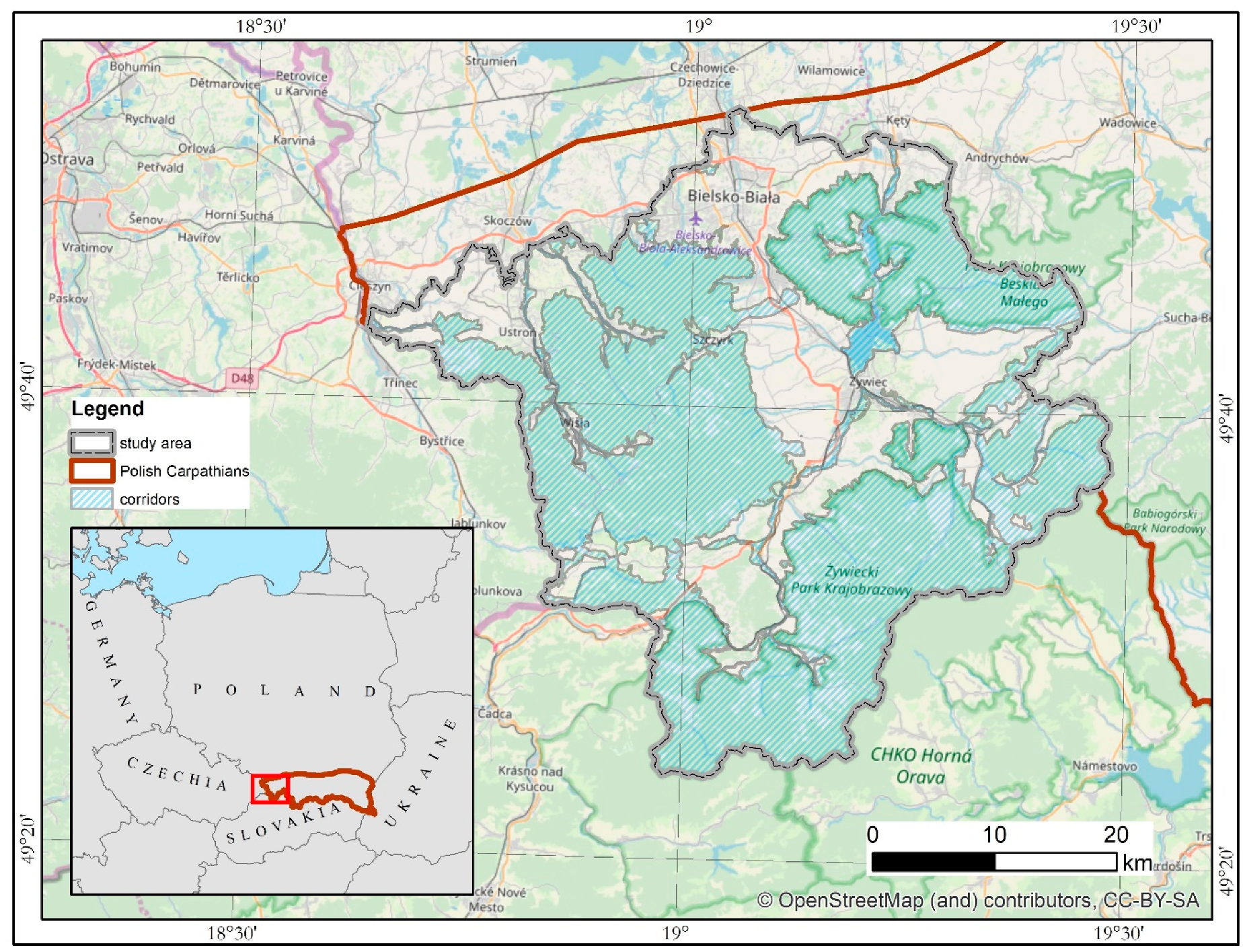
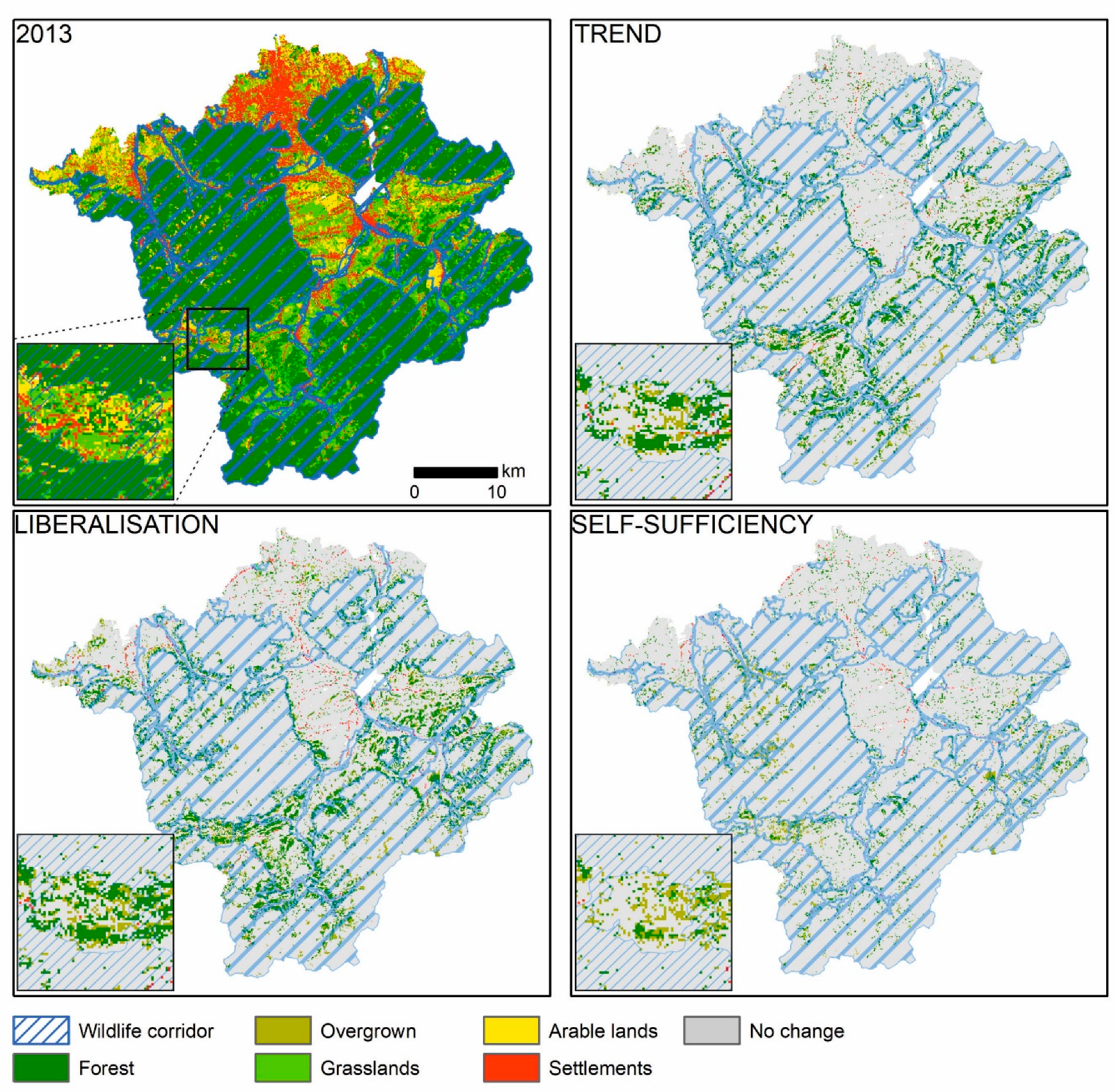
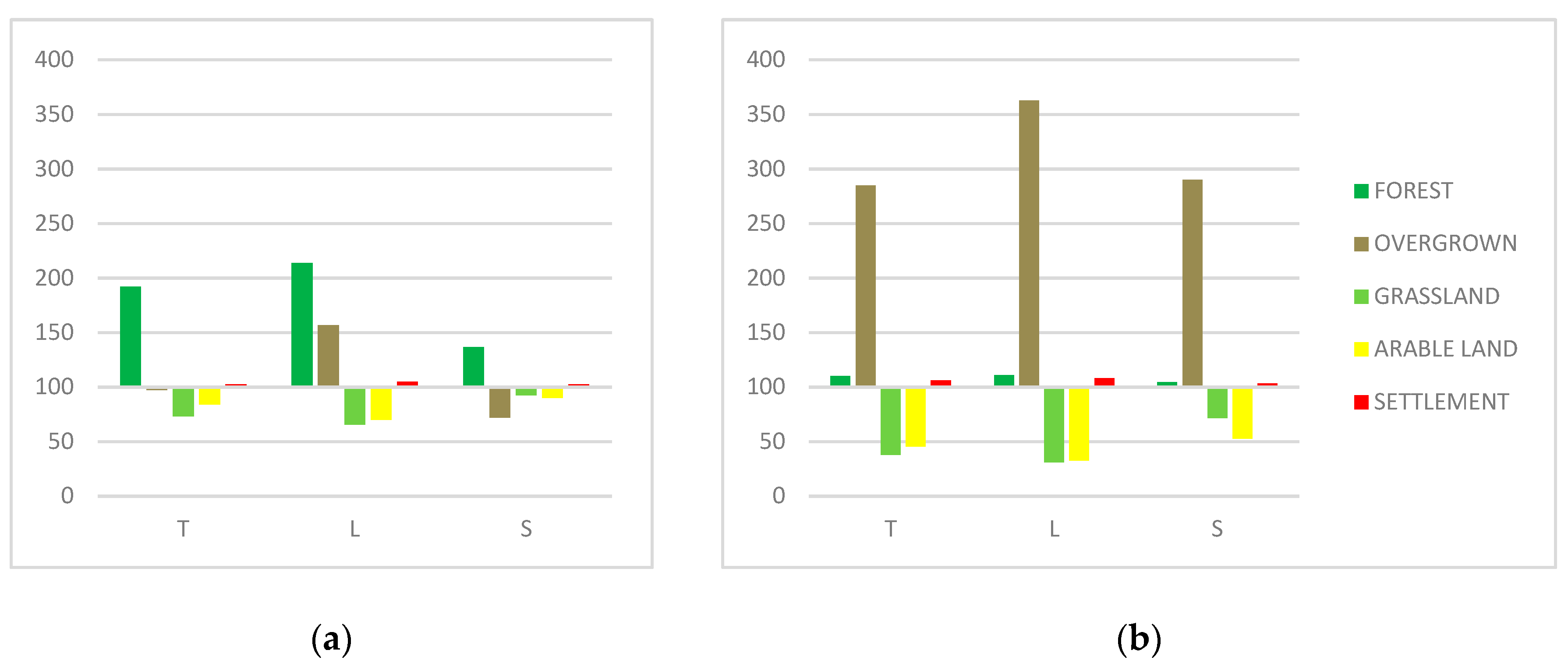
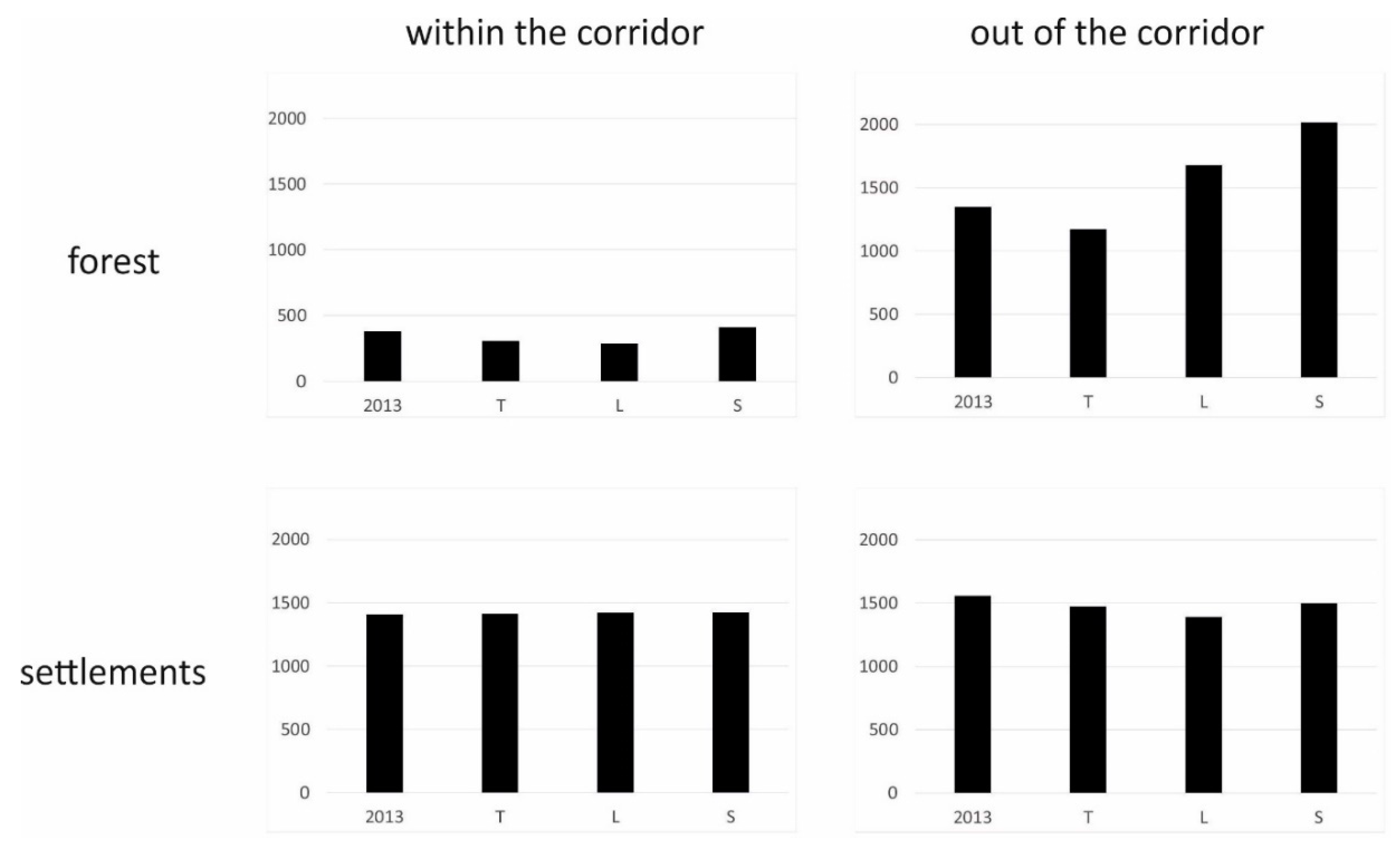
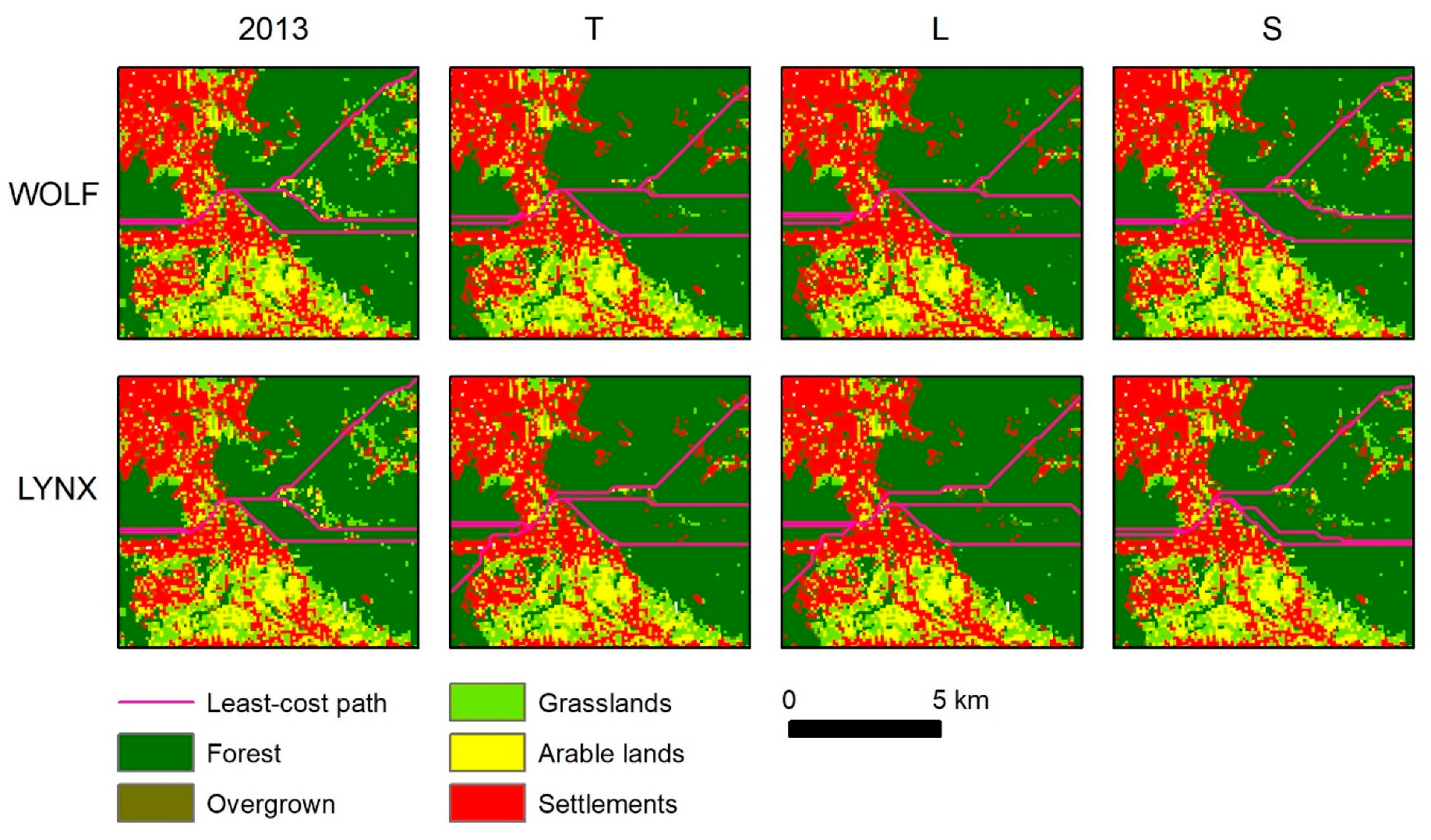
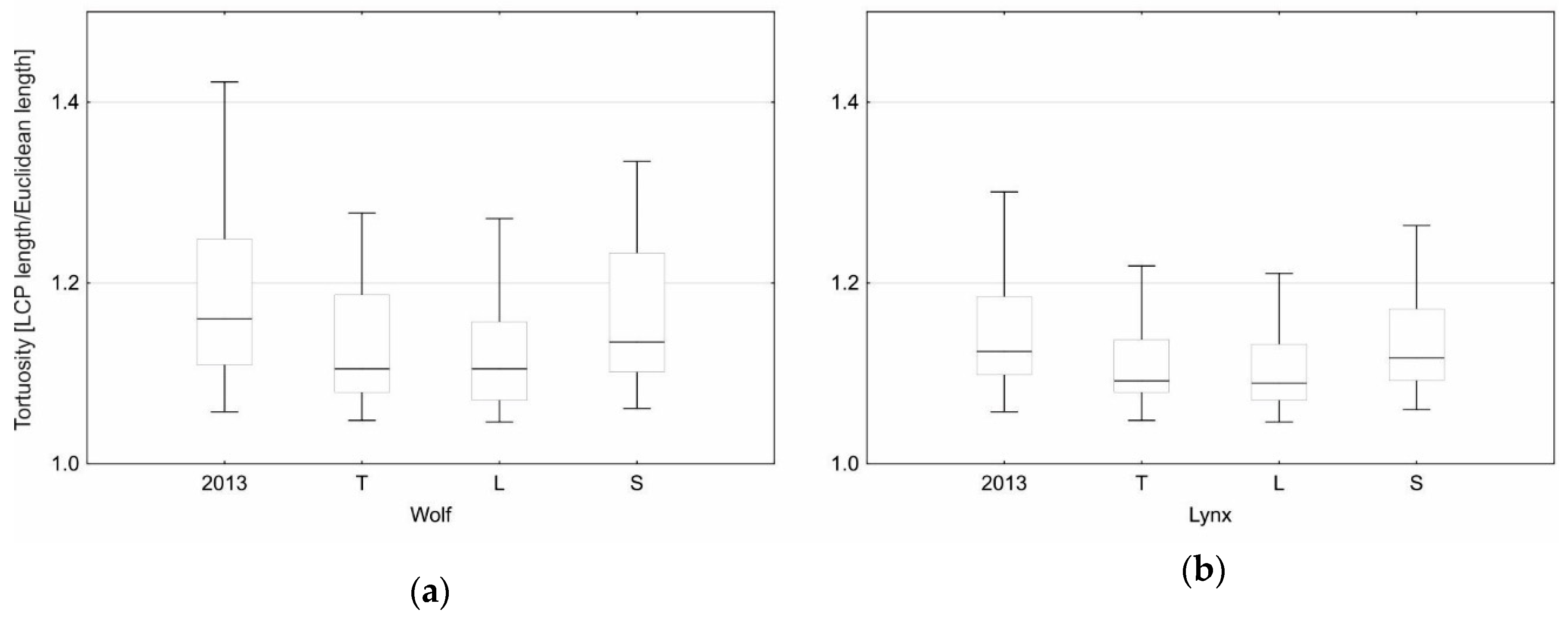
| Land Use Class | Wolf Cost | Lynx Cost |
|---|---|---|
| forest | 8 | 16 |
| overgrown | 32 | 43 |
| grassland | 46 | 62 |
| arable land | 100 | 100 |
| settlements | 68 | 72 |
| Land Use | 2013 | Trend | Liberalisation | Self-Sufficiency |
|---|---|---|---|---|
| forest | 13.2 | 25.4 | 28.2 | 18.1 |
| overgrown | 3.1 | 3.0 | 4.9 | 2.2 |
| grassland | 36.8 | 26.9 | 24.1 | 34.0 |
| arable land | 18.6 | 15.7 | 13.0 | 16.7 |
| settlements | 28.3 | 29.0 | 29.7 | 29.0 |
| Land Use | 2013 | Trend | Liberalisation | Self-Sufficiency |
|---|---|---|---|---|
| forest | 81.1 | 89.3 | 89.9 | 84.7 |
| overgrown | 0.7 | 2.0 | 2.6 | 2.1 |
| grassland | 13.3 | 5.0 | 4.1 | 9.5 |
| arable land | 2.6 | 1.2 | 0.9 | 1.4 |
| settlements | 2.3 | 2.5 | 2.5 | 2.4 |
© 2019 by the authors. Licensee MDPI, Basel, Switzerland. This article is an open access article distributed under the terms and conditions of the Creative Commons Attribution (CC BY) license (http://creativecommons.org/licenses/by/4.0/).
Share and Cite
Kaim, D.; Ziółkowska, E.; Szwagrzyk, M.; Price, B.; Kozak, J. Impact of Future Land Use Change on Large Carnivores Connectivity in the Polish Carpathians. Land 2019, 8, 8. https://doi.org/10.3390/land8010008
Kaim D, Ziółkowska E, Szwagrzyk M, Price B, Kozak J. Impact of Future Land Use Change on Large Carnivores Connectivity in the Polish Carpathians. Land. 2019; 8(1):8. https://doi.org/10.3390/land8010008
Chicago/Turabian StyleKaim, Dominik, Elżbieta Ziółkowska, Marcin Szwagrzyk, Bronwyn Price, and Jacek Kozak. 2019. "Impact of Future Land Use Change on Large Carnivores Connectivity in the Polish Carpathians" Land 8, no. 1: 8. https://doi.org/10.3390/land8010008
APA StyleKaim, D., Ziółkowska, E., Szwagrzyk, M., Price, B., & Kozak, J. (2019). Impact of Future Land Use Change on Large Carnivores Connectivity in the Polish Carpathians. Land, 8(1), 8. https://doi.org/10.3390/land8010008





